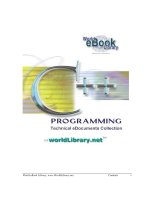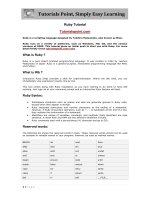C++ Tutorial English ebook
Bạn đang xem bản rút gọn của tài liệu. Xem và tải ngay bản đầy đủ của tài liệu tại đây (2.52 MB, 231 trang )
C++ Tutorial
i
C++TUTORIAL
Simply Easy Learning by tutorialspoint.com
tutorialspoint.com
TUTORIALS POINT
Simply Easy Learning
ABOUT THE TUTORIAL
C++ Tutorial
C++ is a middle-level programming language developed by Bjarne Stroustrup starting in 1979 at Bell
Labs. C++ runs on a variety of platforms, such as Windows, Mac OS, and the various versions of UNIX.
This reference will take you through simple and practical approach while learning C++ Programming
language.
Audience
This reference has been prepared for the beginners to help them understand the basic to advanced
concepts related to C++ Programming languages.
Prerequisites
Before you start doing practice with various types of examples given in this reference, I'm making an
assumption that you are already aware about what is a computer program and what is a computer
programming language?
Copyright & Disclaimer Notice
All the content and graphics on this tutorial are the property of tutorialspoint.com. Any content from
tutorialspoint.com or this tutorial may not be redistributed or reproduced in any way, shape, or form
without the written permission of tutorialspoint.com. Failure to do so is a violation of copyright laws.
This tutorial may contain inaccuracies or errors and tutorialspoint provides no guarantee regarding the
accuracy of the site or its contents including this tutorial. If you discover that the tutorialspoint.com site
or this tutorial content contains some errors, please contact us at
TUTORIALS POINT
Simply Easy Learning
Table of Content
C++ Tutorial 2
Audience 2
Prerequisites 2
Copyright & Disclaimer Notice 2
Overview 11
Object-Oriented Programming 11
Standard Libraries 11
The ANSI Standard 12
Learning C++ 12
Use of C++ 12
Environment Setup 13
Text Editor: 13
C++ Compiler: 13
Installing GNU C/C++ Compiler: 13
Unix/Linux Installation: 13
Mac OS X Installation: 14
Windows Installation: 14
C++ Basic Syntax 15
C++ Program Structure: 15
Compile & Execute C++ Program: 16
Semicolons & Blocks in C++: 16
C++ Identifiers: 17
C++ Keywords: 17
Trigraphs: 18
Whitespace in C++: 18
Comments 19
Data Types 20
Primitive Built-in Types: 20
typedef Declarations: 22
Enumerated Types: 22
Variable Types 23
Variable Declaration in C++: 23
Variable Initialization in C++: Error! Bookmark not defined.
Lvalues and Rvalues: 25
Variable Scope 26
Local Variables: 26
Global Variables: 27
TUTORIALS POINT
Simply Easy Learning
Initializing Local and Global Variables: 27
Constants/Literals 29
Integer literals: 29
Floating-point literals: 29
Boolean literals: 30
Character literals: 30
String literals: 31
Defining Constants: 31
The #define Preprocessor: 31
The const Keyword: 32
Modifier Types 33
Type Qualifiers in C++ 34
Storage Classes 35
The auto Storage Class 35
The register Storage Class 35
The static Storage Class 36
The extern Storage Class 36
The mutable Storage Class 37
Operators 38
Arithmetic Operators: 38
Relational Operators: 40
Logical Operators: 42
Bitwise Operators: 43
Assignment Operators: 45
Misc Operators 47
sizeof operator 47
Conditional operator 48
Comma Operator 49
Member Operator 49
The (.) dot operator: 49
The (->) arrow operator: 50
Casting Operator 50
Pointer Operator & and Pointer Operator * 51
The Address of Operator &: 51
The Indirection Operator *: 51
Operators Precedence in C++: 52
C++ Loop Types 54
while loop 55
Syntax: 55
TUTORIALS POINT
Simply Easy Learning
Flow Diagram: 56
Example: 56
for loop 57
Syntax: 57
Flow Diagram: 58
Example: 58
do…while loop 59
Syntax: 59
Flow Diagram: 59
Example: 60
nested loops 60
Syntax: 60
Example: 61
Loop Control Statements: 62
break statement 62
Syntax: 62
Flow Diagram: 63
Example: 63
continue statement 64
Syntax: 64
Flow Diagram: 64
Example: 64
goto statement 65
Syntax: 65
Flow Diagram: 66
Example: 66
The Infinite Loop: 67
Decision Making 68
if statement 69
Syntax: 69
Flow Diagram: 69
Example: 69
if…else statement 70
Syntax: 70
Flow Diagram: 71
Example: 71
The if else if else Statement: 72
Syntax: 72
Example: 72
TUTORIALS POINT
Simply Easy Learning
switch statement 73
Syntax: 73
Flow Diagram: 74
Example: 74
nested if statements 75
Syntax: 75
Example: 75
nested switch statements 76
Syntax: 76
Example: 76
The ? : Operator: 77
Functions 78
Defining a Function: 78
Example: 79
Function Declarations: 79
Calling a Function: 79
Function Arguments: 80
Default Values for Parameters: 84
Numbers 85
Defining Numbers in C++: 85
Math Operations in C++: 86
Random Numbers in C++: 87
Arrays 89
Declaring Arrays: 89
Initializing Arrays: 89
Accessing Array Elements: 90
C++ Arrays in Detail: 91
Two-Dimensional Arrays: 91
Initializing Two-Dimensional Arrays: 92
Accessing Two-Dimensional Array Elements: 92
Strings 98
The C-Style Character String: 98
The String Class in C++: 100
Pointers 101
What Are Pointers? 101
Using Pointers in C++: 102
C++ Pointers in Detail: 102
Incrementing a Pointer: 104
Decrementing a Pointer: 105
TUTORIALS POINT
Simply Easy Learning
Pointer Comparisons 105
References 113
C++ References vs Pointers: 113
Creating References in C++: 113
Date and Time 117
Current date and time: 118
Format time using struct tm: 118
Basic Input/Output 120
I/O Library Header Files: 120
The standard output stream (cout): 120
The standard input stream (cin): 121
The standard error stream (cerr): 121
The standard log stream (clog): 122
Data Structures 123
Defining a Structure: 123
Accessing Structure Members: 123
Structures as Function Arguments: 125
Pointers to Structures: 126
The typedef Keyword 127
Classes and Objects 128
C++ Class Definitions: 128
Define C++ Objects: 128
Accessing the Data Members: 129
Classes & Objects in Detail: 129
The public members: 134
The private members: 135
The protected members: 136
The Class Constructor: 137
Parameterized Constructor: 138
Using Initialization Lists to Initialize Fields: 139
The Class Destructor: 139
Static Function Members: 148
Inheritance 150
Base & Derived Classes: 150
Access Control and Inheritance: 151
Type of Inheritance: 151
Multiple Inheritances: 152
Overloading 154
Function overloading in C++: 154
TUTORIALS POINT
Simply Easy Learning
Operators overloading in C++: 155
Overloadable/Non-overloadableOperators: 157
Operator Overloading Examples: 157
Polymorphism 170
Virtual Function: 172
Pure Virtual Functions: 172
Data Abstraction 173
Access Labels Enforce Abstraction: 174
Benefits of Data Abstraction: 174
Data Abstraction Example: 174
Designing Strategy: 175
Data Encapsulation 176
Data Encapsulation Example: 177
Designing Strategy: 177
Interfaces 178
Abstract Class Example: 178
Designing Strategy: 180
Files and Streams 181
Opening a File: 181
Closing a File 182
Writing to a File: 182
Reading from a File: 182
Read & Write Example: 182
File Position Pointers: 183
Exception Handling 185
Throwing Exceptions: 185
Catching Exceptions: 186
C++ Standard Exceptions: 187
Define New Exceptions: 188
Dynamic Memory 189
The new and delete operators: 189
Dynamic Memory Allocation for Arrays: 190
Dynamic Memory Allocation for Objects: 190
Namespaces 192
Defining a Namespace: 192
The using directive: 193
Discontiguous Namespaces: 194
Nested Namespaces: 194
Templates 196
TUTORIALS POINT
Simply Easy Learning
Function Template: 196
Class Template: 197
Preprocessor 199
The #define Preprocessor: 199
Function-Like Macros: 200
Conditional Compilation: 200
The # and ## Operators: 201
Predefined C++ Macros: 202
Signal Handling 204
The signal() function: 204
The raise() function: 205
Multithreading 207
Creating Threads: 207
Terminating Threads: 208
Example: 208
Passing Arguments to Threads: 209
Joining and Detaching Threads: 210
Web Programming 212
What is CGI ? 212
Web Browsing 212
CGI Architecture Diagram 213
Web Server Configuration 213
First CGI Program 213
Hello World! This is my first CGI program 214
HTTP Header 214
CGI Environment Variables 214
C++ CGI Library 216
GET and POST Methods 216
Passing Information using GET method: 216
Simple URL Example : Get Method 217
Simple FORM Example: GET Method 218
Passing Information using POST method: 218
Passing Checkbox Data to CGI Program 219
Passing Radio Button Data to CGI Program 220
Passing Text Area Data to CGI Program 221
Passing Drop Down Box Data to CGI Program 222
Using Cookies in CGI 223
How It Works 223
Setting up Cookies 223
TUTORIALS POINT
Simply Easy Learning
Retrieving Cookies 224
File Upload Example: 225
STL Tutorial 227
Standard Library 229
The Standard Function Library: 229
The Object Oriented Class Library: 229
TUTORIALS POINT
Simply Easy Learning
Overview
C
++ is a statically typed, compiled, general-purpose, case-sensitive, free-form programming language
that supports procedural, object-oriented, and generic programming.
C++ is regarded as a middle-level language, as it comprises a combination of both high-level and low-level
language features.
C++ was developed by Bjarne Stroustrup starting in 1979 at Bell Labs in Murray Hill, New Jersey, as an
enhancement to the C language and originally named C with Classes but later it was renamed C++ in 1983.
C++ is a superset of C, and that virtually any legal C program is a legal C++ program.
Note: A programming language is said to use static typing when type checking is performed during compile-time
as opposed to run-time.
Object-Oriented Programming
C++ fully supports object-oriented programming, including the four pillars of object-oriented development:
Encapsulation
Data hiding
Inheritance
Polymorphism
Standard Libraries
Standard C++ consists of three important parts:
The core language giving all the building blocks including variables, data types and literals, etc.
The C++ Standard Library giving a rich set of functions manipulating files, strings, etc.
The Standard Template Library (STL) giving a rich set of methods manipulating data structures, etc.
CHAPTER
1
TUTORIALS POINT
Simply Easy Learning
The ANSI Standard
The ANSI standard is an attempt to ensure that C++ is portable that code you write for Microsoft's compiler will
compile without errors, using a compiler on a Mac, UNIX, a Windows box, or an Alpha.
The ANSI standard has been stable for a while, and all the major C++ compiler manufacturers support the ANSI
standard.
Learning C++
The most important thing to do when learning C++ is to focus on concepts and not get lost in language technical
details.
The purpose of learning a programming language is to become a better programmer; that is, to become more
effective at designing and implementing new systems and at maintaining old ones.
C++ supports a variety of programming styles. You can write in the style of Fortran, C, Smalltalk, etc., in any
language. Each style can achieve its aims effectively while maintaining runtime and space efficiency.
Use of C++
C++ is used by hundreds of thousands of programmers in essentially every application domain.
C++ is being highly used to write device drivers and other softwares that rely on direct manipulation of hardware
under realtime constraints.
C++ is widely used for teaching and research because it is clean enough for successful teaching of basic
concepts.
Anyone who has used either an Apple Macintosh or a PC running Windows has indirectly used C++ because the
primary user interfaces of these systems are written in C++.
TUTORIALS POINT
Simply Easy Learning
Environment Setup
B
efore you start doing programming using C++, you need the following two softwares available on your
computer.
Text Editor:
This will be used to type your program. Examples of few editors include Windows Notepad, OS Edit command,
Brief, Epsilon, EMACS, and vim or vi.
Name and version of text editor can vary on different operating systems. For example, Notepad will be used on
Windows and vim or vi can be used on windows as well as Linux, or UNIX.
The files you create with your editor are called source files, and for C++ they typically are named with the
extension .cpp, .cp, or .c.
Before starting your programming, make sure you have one text editor in place and you have enough experience
to type your C++ program.
C++ Compiler:
This is actual C++ compiler, which will be used to compile your source code into final executable program.
Most C++ compilers don't care what extension you give your source code, but if you don't specify otherwise, many
will use .cpp by default
Most frequently used and free available compiler is GNU C/C++ compiler, otherwise you can have compilers either
from HP or Solaris if you have respective Operating Systems.
Installing GNU C/C++ Compiler:
UNIX/Linux Installation:
If you are using Linux or UNIX, then check whether GCC is installed on your system by entering the following
command from the command line:
$ g++-v
CHAPTER
2
TUTORIALS POINT
Simply Easy Learning
If you have installed GCC, then it should print a message such as the following:
Using built-in specs.
Target: i386-redhat-linux
Configuredwith: /configure prefix=/usr
Thread model: posix
gcc version 4.1.220080704(RedHat4.1.2-46)
If GCC is not installed, then you will have to install it yourself using the detailed instructions available at
Mac OS X Installation:
If you use Mac OS X, the easiest way to obtain GCC is to download the Xcode development environment from
Apple's web site and follow the simple installation instructions.
Xcode is currently available at developer.apple.com/technologies/tools/.
Windows Installation:
To install GCC at Windows, you need to install MinGW. To install MinGW, go to the MinGW homepage,
www.mingw.org, and follow the link to the MinGW download page. Download the latest version of the MinGW
installation program which should be named MinGW-<version>.exe.
While installing MinWG, at a minimum, you must install gcc-core, gcc-g++, binutils, and the MinGW runtime, but
you may wish to install more.
Add the bin subdirectory of your MinGW installation to your PATH environment variable so that you can specify
these tools on the command line by their simple names.
When the installation is complete, you will be able to run gcc, g++, ar, ranlib, dlltool, and several other GNU tools
from the Windows command line.
TUTORIALS POINT
Simply Easy Learning
C++ Basic Syntax
W
hen we consider a C++ program, it can be defined as a collection of objects that communicate via
invoking each other's methods. Let us now briefly look into what do class, object, methods and instant variables
mean.
Object - Objects have states and behaviors. Example: A dog has states - color, name, breed as well as
behaviors - wagging, barking, eating. An object is an instance of a class.
Class - A class can be defined as a template/blueprint that describes the behaviors/states that object of its
type support.
Methods - A method is basically a behavior. A class can contain many methods. It is in methods where the
logics are written, data is manipulated and all the actions are executed.
Instant Variables - Each object has its unique set of instant variables. An object's state is created by the
values assigned to these instant variables.
C++ Program Structure:
Let us look at a simple code that would print the words Hello World.
#include<iostream>
usingnamespace std;
// main() is where program execution begins.
int main()
{
cout <<"Hello World";// prints Hello World
return0;
}
Let us look various parts of the above program:
The C++ language defines several headers, which contain information that is either necessary or useful to
your program. For this program, the header <iostream> is needed.
The line using namespace std; tells the compiler to use the std namespace. Namespaces are a relatively
recent addition to C++.
The next line // main() is where program execution begins. is a single-line comment available in C++.
Single-line comments begin with // and stop at the end of the line.
The line int main() is the main function where program execution begins.
CHAPTER
3
TUTORIALS POINT
Simply Easy Learning
The next line cout << "This is my first C++ program."; causes the message "This is my first C++ program"
to be displayed on the screen.
The next line return 0; terminates main( )function and causes it to return the value 0 to the calling process.
Compile & Execute C++ Program:
Let's look at how to save the file, compile and run the program. Please follow the steps given below:
Open a text editor and add the code as above.
Save the file as: hello.cpp
Open a command prompt and go to the directory where you saved the file.
Type 'g++ hello.cpp' and press enter to compile your code. If there are no errors in your code, the command
prompt will take you to the next line and would generate a.out executable file.
Now, type ' a.out' to run your program.
You will be able to see ' Hello World ' printed on the window.
$ g++ hello.cpp
$ ./a.out
HelloWorld
Make sure that g++ is in your path and that you are running it in the directory containing file hello.cpp.
You can compile C/C++ programs using makefile. For more details, you can check Makefile Tutorial.
Semicolons & Blocks in C++:
In C++, the semicolon is a statement terminator. That is, each individual statement must be ended with a
semicolon. It indicates the end of one logical entity.
For example, following are three different statements:
x = y;
y = y+1;
add(x, y);
A block is a set of logically connected statements that are surrounded by opening and closing braces. For
example:
{
cout <<"Hello World";// prints Hello World
return0;
}
C++ does not recognize the end of the line as a terminator. For this reason, it does not matter where on a line you
put a statement. For example:
x = y;
y = y+1;
add(x, y);
TUTORIALS POINT
Simply Easy Learning
is the same as
x = y; y = y+1; add(x, y);
C++ Identifiers:
A C++ identifier is a name used to identify a variable, function, class, module, or any other user-defined item. An
identifier starts with a letter A to Z or a to z or an underscore (_) followed by zero or more letters, underscores, and
digits (0 to 9).
C++ does not allow punctuation characters such as @, $, and % within identifiers. C++ is a case-sensitive
programming language. Thus, Manpower and manpower are two different identifiers in C++.
Here are some examples of acceptable identifiers:
mohd zara abc move_name a_123
myname50 _temp j a23b9 retVal
C++ Keywords:
The following list shows the reserved words in C++. These reserved words may not be used as constant or
variable or any other identifier names.
Asm
else
new
this
Auto
enum
operator
throw
Bool
explicit
private
true
Break
export
protected
try
Case
extern
public
typedef
Catch
false
register
typeid
Char
float
reinterpret_cast
typename
Class
for
return
union
Const
friend
short
unsigned
const_cast
goto
signed
using
continue
If
sizeof
virtual
Default
inline
Static
void
Delete
int
static_cast
volatile
Do
long
Struct
wchar_t
Double
mutable
Switch
while
dynamic_cast
namespace
Template
TUTORIALS POINT
Simply Easy Learning
Trigraphs:
A few characters have an alternative representation, called a trigraph sequence. A trigraph is a three-character
sequence that represents a single character and the sequence always starts with two question marks.
Trigraphs are expanded anywhere they appear, including within string literals and character literals, in comments,
and in preprocessor directives.
Following are most frequently used trigraph sequences:
Trigraph
Replacement
??=
#
??/
\
??'
^
??(
[
??)
]
??!
|
??<
{
??>
}
??-
~
All the compilers do not support trigraphs and they are not advised to be used because of their confusing nature.
Whitespace in C++:
A line containing only whitespace, possibly with a comment, is known as a blank line, and C++ compiler totally
ignores it.
Whitespace is the term used in C++ to describe blanks, tabs, newline characters and comments. Whitespace
separates one part of a statement from another and enables the compiler to identify where one element in a
statement, such as int, ends and the next element begins. Therefore, in the statement,
int age;
there must be at least one whitespace character (usually a space) between int and age for the compiler to be able
to distinguish them. On the other hand, in the statement,
fruit = apples + oranges;// Get the total fruit
no whitespace characters are necessary between fruit and =, or between = and apples, although you are free to
include some if you wish for readability purpose.
TUTORIALS POINT
Simply Easy Learning
Comments
P
rogram comments are explanatory statements that you can include in the C++ code that you write and
helps anyone reading its source code. All programming languages allow for some form of comments.
C++ supports single-line and multi-line comments. All characters available inside any comment are ignored by
C++ compiler.
C++ comments start with /* and end with */. For example:
/* This is a comment */
/* C++ comments can also
* span multiple lines
*/
A comment can also start with //, extending to the end of the line. For example:
#include<iostream>
usingnamespace std;
main()
{
cout <<"Hello World";// prints Hello World
return0;
}
When the above code is compiled, it will ignore // prints Hello World and final executable will produce the
following result:
HelloWorld
Within a /* and */ comment, // characters have no special meaning. Within a // comment, /* and */ have no special
meaning. Thus, you can "nest" one kind of comment within the other kind. For example:
/* Comment out printing of Hello World:
cout << "Hello World"; // prints Hello World
*/
CHAPTER
4
TUTORIALS POINT
Simply Easy Learning
Data Types
W
hile doing programming in any programming language, you need to use various variables to store
various information. Variables are nothing but reserved memory locations to store values. This means that when
you create a variable you reserve some space in memory.
You may like to store information of various data types like character, wide character, integer, floating point, double
floating point, boolean, etc. Based on the data type of a variable, the operating system allocates memory and
decides what can be stored in the reserved memory.
Primitive Built-in Types:
C++ offer the programmer a rich assortment of built-in as well as user defined data types. Following table lists
down seven basic C++ data types:
Type
Keyword
Boolean
bool
Character
char
Integer
int
Floating point
float
Double floating point
double
Valueless
void
Wide character
wchar_t
Several of the basic types can be modified using one or more of these type modifiers:
signed
unsigned
short
long
CHAPTER
5
TUTORIALS POINT
Simply Easy Learning
The following table shows the variable type, how much memory it takes to store the value in memory, and what is
maximum and minimum vaue, which can be stored in such type of variables.
Type
Typical Bit Width
Typical Range
char
1byte
-127 to 127 or 0 to 255
unsigned char
1byte
0 to 255
signed char
1byte
-127 to 127
int
4bytes
-2147483648 to 2147483647
unsigned int
4bytes
0 to 4294967295
signed int
4bytes
-2147483648 to 2147483647
short int
2bytes
-32768 to 32767
unsigned short int
Range
0 to 65,535
signed short int
Range
-32768 to 32767
long int
4bytes
-2,147,483,647 to 2,147,483,647
signed long int
4bytes
same as long int
unsigned long int
4bytes
0 to 4,294,967,295
float
4bytes
+/- 3.4e +/- 38 (~7 digits)
double
8bytes
+/- 1.7e +/- 308 (~15 digits)
long double
8bytes
+/- 1.7e +/- 308 (~15 digits)
wchar_t
2 or 4 bytes
1 wide character
The sizes of variables might be different from those shown in the above table, depending on the compiler and the
computer you are using.
Following is the example, which will produce correct size of various data types on your computer.
#include<iostream>
usingnamespace std;
int main()
{
cout <<"Size of char : "<<sizeof(char)<< endl;
cout <<"Size of int : "<<sizeof(int)<< endl;
cout <<"Size of short int : "<<sizeof(shortint)<< endl;
cout <<"Size of long int : "<<sizeof(longint)<< endl;
cout <<"Size of float : "<<sizeof(float)<< endl;
cout <<"Size of double : "<<sizeof(double)<< endl;
cout <<"Size of wchar_t : "<<sizeof(wchar_t)<< endl;
return0;
}
This example uses endl, which inserts a new-line character after every line and << operator is being used to pass
multiple values out to the screen. We are also using sizeof() function to get size of various data types.
TUTORIALS POINT
Simply Easy Learning
When the above code is compiled and executed, it produces the following result, which can vary from machine to
machine:
Size of char:1
Size of int:4
Size of shortint:2
Size of longint:4
Size of float:4
Size of double:8
Size of wchar_t:4
typedef Declarations:
You can create a new name for an existing type using typedef. Following is the simple syntax to define a new type
using typedef:
typedef type newname;
For example, the following tells the compiler that feet is another name for int:
typedefint feet;
Now, the following declaration is perfectly legal and creates an integer variable called distance:
feet distance;
Enumerated Types:
An enumerated type declares an optional type name and a set of zero or more identifiers that can be used as
values of the type. Each enumerator is a constant whose type is the enumeration.
To create an enumeration requires the use of the keyword enum. The general form of an enumeration type is:
enumenum-name { list of names }var-list;
Here, the enum-name is the enumeration's type name. The list of names is comma separated.
For example, the following code defines an enumeration of colors called colors and the variable c of type color.
Finally, c is assigned the value "blue".
enum color { red, green, blue } c;
c = blue;
By default, the value of the first name is 0, the second name has the value 1, the third has the value 2, and so on.
But you can give a name a specific value by adding an initializer. For example, in the following
enumeration, green will have the value 5.
enum color { red, green=5, blue };
Here, blue will have a value of 6 because each name will be one greater than the one that precedes it.
TUTORIALS POINT
Simply Easy Learning
Variable Types
A
variable provides us with named storage that our programs can manipulate. Each variable in C++ has a
specific type, which determines the size and layout of the variable's memory; the range of values that can be
stored within that memory; and the set of operations that can be applied to the variable.
The name of a variable can be composed of letters, digits, and the underscore character. It must begin with either
a letter or an underscore. Upper and lowercase letters are distinct because C++ is case-sensitive:
There are following basic types of variable in C++ as explained in last chapter:
Type
Description
Bool
Stores either value true or false.
Char
Typically a single octet(one byte). This is an integer type.
Int
The most natural size of integer for the machine.
Float
A single-precision floating point value.
Double
A double-precision floating point value.
Void
Represents the absence of type.
wchar_t
A wide character type.
C++ also allows to define various other types of variables, which we will cover in subsequent chapters
like Enumeration, Pointer, Array, Reference, Data structures, and Classes.
Following section will cover how to define, declare and use various types of variables.
Variable Definition in C++:
A variable definition means to tell the compiler where and how much to create the storage for the variable. A
variable definition specifies a data type, and contains a list of one or more variables of that type as follows:
type variable_list;
CHAPTER
6
TUTORIALS POINT
Simply Easy Learning
Here, type must be a valid C++ data type including char, w_char, int, float, double, bool or any user-defined
object, etc., and variable_list may consist of one or more identifier names separated by commas. Some valid
declarations are shown here:
int i, j, k;
char c, ch;
float f, salary;
double d;
The line int i, j, k; both declares and defines the variables i, j and k; which instructs the compiler to create
variables named i, j and k of type int.
Variables can be initialized (assigned an initial value) in their declaration. The initializer consists of an equal sign
followed by a constant expression as follows:
type variable_name = value;
Some examples are:
extern int d = 3, f = 5; // declaration of d and f.
int d = 3, f = 5; // definition and initializing d and f.
byte z = 22; // definition and initializes z.
char x = 'x'; // the variable x has the value 'x'.
For definition without an initializer: variables with static storage duration are implicitly initialized with NULL (all
bytes have the value 0); the initial value of all other variables is undefined.
Variable Declaration in C++:
A variable declaration provides assurance to the compiler that there is one variable existing with the given type
and name so that compiler proceed for further compilation without needing complete detail about the variable. A
variable declaration has its meaning at the time of compilation only, compiler needs actual variable declaration at
the time of linking of the program.
A variable declaration is useful when you are using multiple files and you define your variable in one of the files,
which will be available at the time of linking of the program. You will use extern keyword to declare a variable at
any place. Though you can declare a variable multiple times in your C++ program, but it can be defined only once
in a file, a function or a block of code.
Example
Try the following example where variables have been declared at the top, but they have been defined and
initialized inside the main function:
#include<iostream>
usingnamespace std;
// Variable definition:
extern int a, b;
extern int c;
extern float f;
int main ()
{
// Variable definition:
int a, b;









